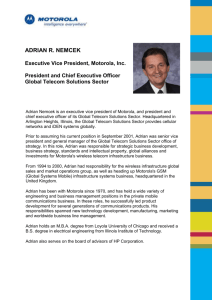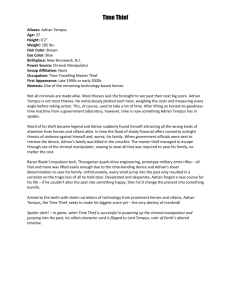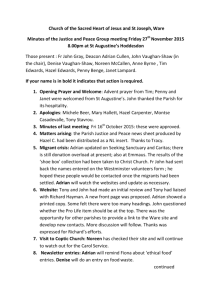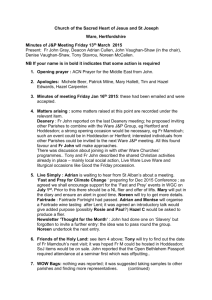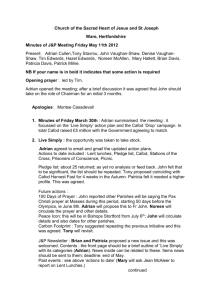RYANAIR / AER LINGUS: Merger of highly differentiated services
advertisement
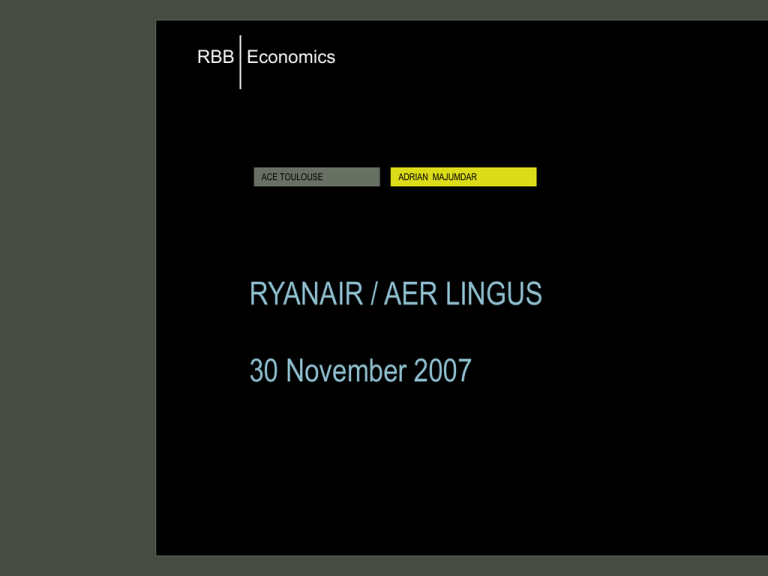
RBB Economics ACE TOULOUSE ADRIAN MAJUMDAR RYANAIR / AER LINGUS 30 November 2007 RBB Economics ADRIAN MAJUMDAR Merger of highly differentiated services 30 NOVEMBER 2007 Adrian.Majumdar@rbbecon.com 2 • Product differentiation: • Ryanair (FR) “low frills” vs Aer Lingus (EI) “mid frills”, by its own admission • FR average fare (€41) less than half that of EI (€91) • Geographic differentiation: • EI flies DUB to “primary” airport • FR flies (typically) DUB to “secondary” airports • Overlap on 16 “airport pairs” and further 19 “city pairs” • European Commission (EC) used econometrics to assess closeness of competition… RBB Economics ADRIAN MAJUMDAR Commission results: impact of FR frequency on EI fares 30 NOVEMBER 2007 Adrian.Majumdar@rbbecon.com 3 • EC adopts fixed effects panel for Irish routes. Taking results at face value: • “a 1% increase in Ryanair frequencies… is associated with a 0.028% reduction in Aer Lingus’ prices” (A IV, 218) • “a 1% increase in frequencies by Ryanair is associated, respectively, with a 0.044% and 0.026% decrease in Aer Lingus’ fares when serving the same airport or a different airport in the same city-pair” (A IV, 229 [with typo corrected]) • FR is not a strong constraint on EI. 20% increase in FR frequency would not even have 1% impact on EI fares! RBB Economics • When FR present, its share is substantial, c. 40-60% typically • “…on average, Aer Lingus prices are 7.7% lower when Ryanair is also present on the route…” (A IV, 200) 4 • But FR not likely to reduce frequency substantially post merger Adrian.Majumdar@rbbecon.com ADRIAN MAJUMDAR Commission results: presence of FR • Would not be profitable to withdraw from overlap routes • FR has obligations to (nearly) double its fleet in next 5 years, with options to (nearly) triple it. 30 NOVEMBER 2007 • So any reductions in frequency, if at all, would be marginal… • and the EC frequency regression implies such changes will have no noticeable impact on EI fares RBB Economics ADRIAN MAJUMDAR Double standards • Welcome use of empirical analysis & “data room” but must treat all evidence equally, a few (of many) examples include • EC and EI regressions suffer from endogeneity: EI fare regressed on EI frequency, +ve sign consistent with demand determining fares and frequency together (as with +ve sign for other rivals) • EC critique of FR approach – bias arises from correlation of EI entry and cost and demand variables. OK but if entry is endogenous, the same bias arises in EC panel. • EC Claim that presence regression is “extraordinarily robust” (A IV, 299), BUT minor change in modeling seasonality and allowing for within route serial correlation has substantial impact both in reducing coefficient AND removing statistical significance of FR presence • NB: also different standards for evidence on operating cost comparisons and, crucially, base competition. 30 NOVEMBER 2007 Adrian.Majumdar@rbbecon.com 5 RBB Economics ADRIAN MAJUMDAR Does EI constrain FR? 30 NOVEMBER 2007 Adrian.Majumdar@rbbecon.com 6 • EI very rarely enters FR routes so not sufficient variation for standard fixed effects approach… but can combine some benefits of panel with cross section to test impact of EI… • No systematic effect of EI on FR is found (Annex IV, para 316). • “Asymmetric constraint” is intuitive… FR more likely to constrain EI than the reverse, since: • FR more efficient and dynamic (track record of growth and fares reductions) • On average, FR fares less than half of EI fares • Commission results indicate that FR constraint on EI is small even on airport pairs… so the EI constraint on FR is, at most, very small RBB Economics ADRIAN MAJUMDAR Barriers to entry • Entry required only to restore lost competitive constraints • Asymmetric constraints… 30 NOVEMBER 2007 Adrian.Majumdar@rbbecon.com 7 • No material constraint on FR lost, so none to restore • Key question: would entry prevent higher EI fares? • New entry is common place in airline industry and supported very recently by OFT, BKA • OFT BA Connect / FlyBe (merger to monopoly constrained by ease of entry) • BKA (Air Berlin/LTU – low entry barriers) RBB Economics ADRIAN MAJUMDAR Base competition (1) • EC Claim: Being based at an airport generates the following airport related advantages: • scale economies which reduce cost 30 NOVEMBER 2007 Adrian.Majumdar@rbbecon.com 8 • ability to respond quickly to anticipated demand shocks • NOTE: “bases” are not “hubs” • Point-to-point “bases” do not benefit from “feeder traffic” (as EC acknowledges) RBB Economics ADRIAN MAJUMDAR Base competition (2) 30 NOVEMBER 2007 Adrian.Majumdar@rbbecon.com 9 • No empirical evidence of substantial cost advantages: • Cost advantages tend to be network related (e.g. network wide bargaining with ground handlers) • FR operational costs do not differ at Cork (one FR aircraft based) and Dublin (19 aircraft based). Further, increment in FR Dublin based aircraft by 50% had no impact on reducing operating costs. • Marketing economies exist but are not substantial – FR has v low advertising spend per pax despite period of rapid expansion to new bases and new countries • Above evidence rejected yet EI cost efficiency claims based on assertion (as EI admitted) were taken at face value and unchallenged (double standards) RBB Economics ADRIAN MAJUMDAR Base competition (3) 30 NOVEMBER 2007 Adrian.Majumdar@rbbecon.com 10 • “Flexibility” claims are speculative: • EC Claim: more aircraft based gives more flexibility • BUT actually more flexibility arises when bases are spread out (cf FR’s strategy to serve DUB from aircraft based in the UK). • Anticipated demand is, by definition, easy to meet (cf seasonal ski or sun routes – the hallmark of the charter model) [NB – EC acknowledged charters to be “in” the market] RBB Economics ADRIAN MAJUMDAR Competition from “other end” of the route 30 NOVEMBER 2007 Adrian.Majumdar@rbbecon.com 11 • New entry is common place in airline industry and supported very recently by OFT, BKA • Base advantages are small and would certainly apply for rivals based at the destination for whom new entry would be straightforward • 23/35 “overlap” routes have competitor based at destination (and where rival not based at destination, routes typically are seasonal, i.e. suitable for charter entry) RBB Economics ADRIAN MAJUMDAR Commission claims regarding potential competitors 30 NOVEMBER 2007 Adrian.Majumdar@rbbecon.com 12 • Less committed to DUB, but • why if entry / expansion driven by pursuit of profit? • Different business models, but • same applies to FR and EI; EI is mid frills, FR low frills • entry needs constrain EI, not FR • Flag carriers, Aer Arann, bmi, etc would take EI’s profitable later bookers (i.e. business), so important competitors • Disadvantaged if most originating pax are Irish, but • applies for minority of routes (i.e. rivals typically have advantage) • strong Irish origination applies primarily for seasonal routes suitable for charter entry RBB Economics ADRIAN MAJUMDAR Reputation as a barrier to entry (1) 30 NOVEMBER 2007 Adrian.Majumdar@rbbecon.com 13 • Theory • Price high now, protected by threat to lower price in response to entry • Reality • FR prices low now; FR does not price higher on “monopoly” routes • Entry “deterred” because consumers are currently well served – this is NOT an entry barrier! • EC claim that FR increased entry barriers by fighting off entry (6 examples) but post exit, FR’s fare was lower and capacity higher than the pre-entry scenario… consistent with FR needing to offer a better deal to deter entry (contestability) • Over 60 examples of entry against FR in 3 years RBB Economics ADRIAN MAJUMDAR Reputation (2) How can FR strategy have raised entry barriers, if FR offers a better deal post-exit relative to pre-entry? utility 30 NOVEMBER 2007 Adrian.Majumdar@rbbecon.com 14 Asserted aggressive strategy Post-exit utility Pre-entry utility time RBB Economics ADRIAN MAJUMDAR Congestion • Peak time capacity constraints? • Not important for leisure routes (unlike business pax where travel is time critical) 30 NOVEMBER 2007 Adrian.Majumdar@rbbecon.com 15 • Not an issue if based at the destination since do not arrive and depart at peak times • In any case, FR offers slot remedies RBB Economics ADRIAN MAJUMDAR Efficiencies 30 NOVEMBER 2007 Adrian.Majumdar@rbbecon.com 16 • FR has track record for fare reduction, cost reduction, output expansion and improving efficiency of acquired airlines (cf Buzz integration 2003) • Merger specific: – FR’s substantially larger network generates purchasing economies clearly not possible via EI organic growth! – FR 12 routes in 1996, 540 routes in 2007; considerably larger fleet than that of EI – FR turnaround at DUB 25 mins vs EI at 40-55 mins… EI has observed this yet failed to emulate this efficiency • Verifiable: Benefits of bulk buying well known; turnaround times observable • Customer benefits: Incremental decision is an additional frequency. Lower ownership and operational costs plus faster turnaround times should increase frequencies. • FR so confident of efficiencies that volunteers EI fare reduction RBB Economics ADRIAN MAJUMDAR Ryanair’s case in a nutshell 30 NOVEMBER 2007 Adrian.Majumdar@rbbecon.com 17 • Merger of highly differentiated services, even on airport pairs but especially on city pairs • Commission’s empirical analysis implies limited lost competitive constraint on Aer Lingus; no material constraint lost on Ryanair • New entry is abundant in the airline sector and this threat would “restore” any lost constraint on the parties (notably on Aer Lingus) • Aer Lingus would benefit from substantial operating and aircraft ownership efficiencies such that increasing frequencies becomes more attractive (i.e. output expansion) • At most, minor remedies to facilitate entry would be required. RBB Economics ADRIAN MAJUMDAR BACKGROUND FOR REFERENCE • Commission survey was not best practice! 30 NOVEMBER 2007 Adrian.Majumdar@rbbecon.com 18 • Remedies RBB Economics ADRIAN MAJUMDAR Passenger survey – not best practice! • Self completion survey (i.e. respondents fill in details themselves) • Selection issues • e.g. to assess importance of business passengers on LondonDUB, EI pax traveling on a Saturday (and then compared to FR pax traveling midweek)! • At face value, EC survey did not support city pair at London, e.g. only 18% of EI pax “considered” FR • Results weighted inappropriately • Framing effects / complex questions • Clear contradictions with CAA “best-practice” survey results • Respondents steered to cite FR and EI above others… – Inappropriate use of term “consider” – Signpost FR and EI but not their competitors 30 NOVEMBER 2007 Adrian.Majumdar@rbbecon.com 19 30 NOVEMBER 2007 Adrian.Majumdar@rbbecon.com ADRIAN MAJUMDAR RBB Economics Framing effects – steer towards FR and EI 20 RBB Economics ADRIAN MAJUMDAR Remedies • SIEC asserted on all overlaps yet weak evidence for across the board SIEC, especially where rival based at other end or city pair with high share of time sensitive pax using EI (i.e. London) • Traditionally congestion is the main barrier to entry. Rejection of slot commitments to facilitate entry is a (surprising) rejection of threat of new entry as sufficient constraint • Up-front buyer with many based aircraft at DUB • critical issue but only one paragraph in decision (395) devoted to “base advantages increase with size of the base” 30 NOVEMBER 2007 Adrian.Majumdar@rbbecon.com 21 • no empirical evidence to support required number of based aircraft (EC requirement contradicts even EI’s claim regarding extent of base efficiencies) • FR offers 2 based for DUB-LON plus [4-8] based immediately with scope for up to 10. EC denies opportunity for gradual build up of based aircraft.
